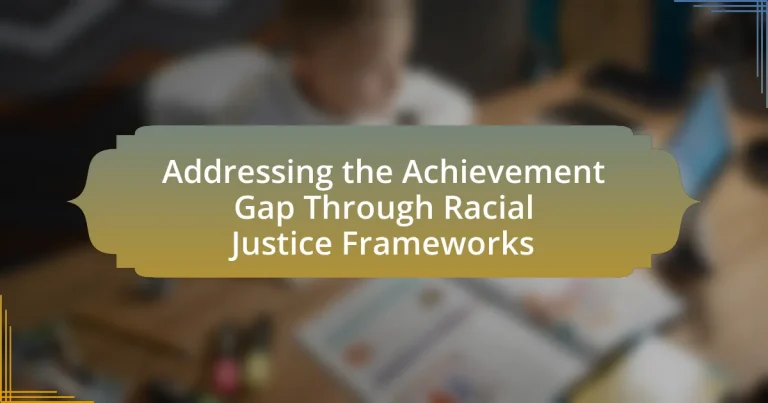The article focuses on addressing the achievement gap through racial justice frameworks, highlighting the disparities in academic performance among students based on socioeconomic status, race, and ethnicity. It examines the factors contributing to this gap, including systemic inequalities and access to quality education, and discusses the role of socioeconomic status in educational outcomes. The article emphasizes the importance of implementing racial justice frameworks to promote equity in education, detailing key principles such as equity, inclusion, and accountability. Additionally, it explores the long-term consequences of failing to address the achievement gap and provides practical strategies for educators, policymakers, and communities to foster an inclusive learning environment and improve educational equity.

What is the Achievement Gap and How Does it Relate to Racial Justice?
The Achievement Gap refers to the disparity in academic performance between groups of students, particularly those defined by socioeconomic status, race, and ethnicity. This gap is closely related to racial justice as it highlights systemic inequalities that affect educational opportunities and outcomes for marginalized racial groups. For instance, data from the National Assessment of Educational Progress (NAEP) consistently shows that Black and Hispanic students score lower than their White peers in reading and mathematics, indicating a persistent achievement gap that reflects broader societal inequities. Addressing this gap through racial justice frameworks involves implementing policies and practices that promote equity in education, ensuring that all students have access to the resources and support necessary for academic success.
What factors contribute to the achievement gap among different racial groups?
The achievement gap among different racial groups is primarily influenced by socioeconomic status, access to quality education, and systemic inequalities. Socioeconomic status affects resources available to students, including access to tutoring, extracurricular activities, and technology. Research indicates that students from lower-income families often attend underfunded schools, which lack experienced teachers and advanced coursework, contributing to lower academic performance. Additionally, systemic inequalities, such as discrimination and bias within educational institutions, further exacerbate disparities in educational outcomes. For instance, studies show that Black and Hispanic students are more likely to be suspended or expelled than their white peers, which negatively impacts their academic achievement.
How do socioeconomic status and access to resources impact educational outcomes?
Socioeconomic status and access to resources significantly impact educational outcomes by influencing students’ academic performance and opportunities for learning. Students from higher socioeconomic backgrounds typically have access to better educational resources, such as experienced teachers, advanced coursework, and extracurricular activities, which enhance their learning experiences. In contrast, students from lower socioeconomic backgrounds often face challenges like underfunded schools, limited access to technology, and fewer educational materials, leading to lower academic achievement. Research indicates that children from low-income families are less likely to perform at grade level in reading and math, with studies showing that socioeconomic disparities account for a substantial portion of the achievement gap observed in standardized test scores.
What role does systemic racism play in perpetuating the achievement gap?
Systemic racism significantly contributes to the achievement gap by creating and maintaining disparities in educational access and resources. This form of racism manifests through policies and practices that disadvantage students of color, leading to unequal funding for schools, lower-quality educational materials, and fewer experienced teachers in predominantly minority schools. For instance, a report by the U.S. Department of Education in 2016 highlighted that schools serving predominantly Black and Latino students receive about $23 billion less in funding than those serving mostly white students. This funding disparity directly impacts the quality of education and opportunities available to students, thereby perpetuating the achievement gap.
Why is addressing the achievement gap important for society?
Addressing the achievement gap is important for society because it promotes equity and social justice, ensuring that all individuals have access to quality education and opportunities for success. When the achievement gap is narrowed, it leads to a more educated workforce, which is essential for economic growth and stability. Research indicates that closing the achievement gap can increase GDP by as much as 2.5% annually, highlighting the economic benefits of educational equity. Furthermore, addressing this gap fosters social cohesion and reduces crime rates, as education is linked to lower levels of poverty and improved community well-being.
How does the achievement gap affect economic mobility and social equity?
The achievement gap significantly hinders economic mobility and social equity by perpetuating disparities in educational outcomes among different demographic groups. When students from disadvantaged backgrounds receive lower-quality education, they are less likely to attain the skills and qualifications necessary for higher-paying jobs, which directly impacts their economic mobility. For instance, research from the National Center for Education Statistics indicates that students from low-income families are less likely to graduate from high school and pursue higher education, leading to a cycle of poverty. This educational inequity also translates into social inequity, as marginalized groups face systemic barriers that limit their access to resources, opportunities, and social capital. Consequently, the achievement gap not only affects individual economic prospects but also reinforces broader societal inequalities, making it a critical issue in the pursuit of racial justice and equity.
What are the long-term consequences of failing to address the achievement gap?
Failing to address the achievement gap leads to significant long-term consequences, including perpetuated socioeconomic disparities and reduced economic mobility. Research indicates that students from disadvantaged backgrounds who do not receive adequate educational support are less likely to graduate from high school, which correlates with lower lifetime earnings. For instance, a report by the National Center for Education Statistics shows that high school graduates earn approximately $10,000 more annually than dropouts. Additionally, communities with persistent achievement gaps often experience higher rates of poverty and unemployment, as educational attainment directly influences job opportunities and economic stability. This cycle of disadvantage can hinder overall societal progress and exacerbate inequalities across generations.

How Can Racial Justice Frameworks Address the Achievement Gap?
Racial justice frameworks can address the achievement gap by promoting equitable access to educational resources and opportunities for marginalized communities. These frameworks emphasize the need to dismantle systemic barriers that disproportionately affect students of color, such as funding disparities, biased disciplinary practices, and lack of representation in curricula. Research indicates that schools implementing racial justice frameworks see improved academic outcomes; for instance, a study by the Education Trust found that equitable funding can lead to a 20% increase in graduation rates for underfunded schools serving predominantly minority populations. By prioritizing equity and inclusion, racial justice frameworks create an environment where all students can thrive academically.
What are the key principles of racial justice frameworks?
The key principles of racial justice frameworks include equity, inclusion, and accountability. Equity emphasizes fair treatment and access to resources for all racial groups, addressing systemic disparities. Inclusion focuses on ensuring that marginalized voices are heard and represented in decision-making processes. Accountability involves holding institutions and individuals responsible for actions that perpetuate racial injustice. These principles are supported by research indicating that equitable policies can significantly reduce achievement gaps in education, as demonstrated by studies from the National Education Association, which highlight the importance of addressing systemic barriers to improve outcomes for students of color.
How do these principles apply to educational policies and practices?
The principles of racial justice frameworks apply to educational policies and practices by promoting equity, inclusivity, and culturally responsive teaching. These frameworks advocate for systemic changes that address disparities in educational outcomes among different racial and ethnic groups. For instance, research indicates that implementing culturally relevant pedagogy can enhance student engagement and achievement, particularly for marginalized populations. A study by Ladson-Billings (1994) highlights that when curricula reflect the diverse backgrounds of students, it leads to improved academic performance and a reduction in the achievement gap. Thus, educational policies that integrate these principles can create more equitable learning environments and foster better educational outcomes for all students.
What examples exist of successful racial justice frameworks in education?
Successful racial justice frameworks in education include the “Culturally Relevant Pedagogy” developed by Gloria Ladson-Billings, which emphasizes the importance of students’ cultural references in learning. This framework has been shown to improve student engagement and academic performance among marginalized groups. Another example is the “Equity Literacy Framework” by Paul Gorski, which focuses on developing educators’ skills to recognize and address inequities in their classrooms, leading to more inclusive educational environments. Additionally, the “Restorative Justice in Education” model has been implemented in various schools to address disciplinary disparities and promote a more equitable approach to student behavior management, resulting in reduced suspension rates among students of color. These frameworks have demonstrated effectiveness in narrowing the achievement gap and fostering a more equitable educational landscape.
How can schools implement racial justice frameworks effectively?
Schools can implement racial justice frameworks effectively by integrating culturally responsive teaching practices and fostering an inclusive curriculum. Culturally responsive teaching acknowledges the diverse backgrounds of students and adapts instructional methods to meet their needs, which has been shown to improve engagement and academic performance among marginalized groups. Research by Ladson-Billings (1994) highlights that such practices can lead to higher achievement levels for students of color by validating their cultural identities within the learning environment. Additionally, schools should establish partnerships with community organizations to support students and families, ensuring that resources are accessible and relevant. This approach not only addresses the achievement gap but also promotes a sense of belonging and equity within the school community.
What strategies can educators use to promote equity in the classroom?
Educators can promote equity in the classroom by implementing differentiated instruction tailored to meet diverse student needs. This approach allows teachers to modify content, process, and products based on individual learning styles and abilities, ensuring that all students have access to the curriculum. Research indicates that differentiated instruction can lead to improved academic outcomes for marginalized groups, as it addresses specific barriers to learning. For instance, a study by Tomlinson (2001) highlights that when educators adapt their teaching strategies, students from various backgrounds demonstrate higher engagement and achievement levels.
How can community involvement enhance the effectiveness of these frameworks?
Community involvement can enhance the effectiveness of racial justice frameworks by fostering collaboration and ensuring that the needs of marginalized groups are accurately represented. Engaging community members allows for the incorporation of local knowledge and perspectives, which can lead to more relevant and tailored solutions. For instance, research from the National Education Association indicates that schools with strong community ties see improved student outcomes, as these partnerships create a support system that addresses both academic and social needs. This collaborative approach not only builds trust but also empowers communities to take an active role in shaping educational policies, ultimately leading to a more equitable achievement landscape.

What Challenges Exist in Implementing Racial Justice Frameworks?
Implementing racial justice frameworks faces significant challenges, including systemic resistance, lack of resources, and insufficient community engagement. Systemic resistance often stems from entrenched institutional practices and policies that prioritize the status quo over equitable change. For instance, educational institutions may struggle to shift curricula or policies that have historically marginalized certain racial groups. Additionally, lack of resources, both financial and human, can hinder the development and sustainability of effective racial justice initiatives. A report by the National Education Association highlights that many schools lack the funding necessary to implement comprehensive racial equity training programs. Lastly, insufficient community engagement can lead to a disconnect between the frameworks and the needs of the communities they aim to serve, resulting in ineffective or poorly received initiatives. Research from the American Psychological Association indicates that community involvement is crucial for the success of racial justice efforts, as it fosters trust and collaboration.
What resistance do educators and institutions face when addressing the achievement gap?
Educators and institutions face significant resistance when addressing the achievement gap, primarily due to systemic biases and entrenched educational practices. These biases often manifest as a lack of awareness or acknowledgment of the disparities in educational outcomes among different racial and socioeconomic groups. For instance, research from the National Center for Education Statistics indicates that students from marginalized backgrounds consistently score lower on standardized tests compared to their peers, highlighting the need for targeted interventions. Additionally, institutional inertia and reluctance to change existing curricula or teaching methods further impede progress. Resistance can also stem from stakeholders who may prioritize traditional metrics of success over equity-focused approaches, thereby hindering the implementation of effective strategies aimed at closing the achievement gap.
How can misconceptions about racial justice hinder progress?
Misconceptions about racial justice can significantly hinder progress by perpetuating stereotypes and fostering division among communities. These misconceptions often lead to a lack of understanding regarding systemic inequalities, which can result in ineffective policies that fail to address the root causes of the achievement gap. For instance, a 2020 report by the National Education Association highlights that misconceptions about the capabilities of students from marginalized backgrounds can lead to lower expectations and reduced support, ultimately affecting educational outcomes. By failing to recognize the complexities of racial justice, stakeholders may implement solutions that do not adequately address the needs of all students, thereby stalling meaningful progress in closing the achievement gap.
What institutional barriers must be overcome to implement effective change?
To implement effective change in addressing the achievement gap through racial justice frameworks, institutional barriers such as entrenched policies, lack of funding, and resistance to change must be overcome. Entrenched policies often prioritize traditional educational practices that do not address the unique needs of marginalized students, thereby perpetuating inequities. Lack of funding limits the resources available for implementing innovative programs aimed at closing the achievement gap. Additionally, resistance to change from stakeholders, including educators and administrators, can hinder the adoption of new frameworks that promote racial justice in education. These barriers must be systematically addressed to create an equitable educational environment.
How can stakeholders collaborate to overcome these challenges?
Stakeholders can collaborate to overcome challenges in addressing the achievement gap through racial justice frameworks by forming partnerships that leverage diverse resources and expertise. Collaborative efforts can include joint initiatives between schools, community organizations, and local governments to create equitable educational opportunities. For example, the “Community Schools” model, which integrates academic, health, and social services, has shown success in improving student outcomes by fostering community involvement and support. Research indicates that such collaborative approaches can lead to a 10-20% increase in student performance, particularly in underserved populations. By sharing data, resources, and best practices, stakeholders can effectively address systemic barriers and promote inclusive educational environments.
What role do policymakers play in supporting racial justice initiatives?
Policymakers play a crucial role in supporting racial justice initiatives by creating and implementing laws and policies that promote equity and address systemic discrimination. They can allocate funding for programs aimed at reducing disparities in education, healthcare, and employment, which are essential for closing the achievement gap. For instance, the Every Student Succeeds Act (ESSA) emphasizes the need for states to address the educational needs of disadvantaged students, thereby reinforcing the importance of equitable resources. Additionally, policymakers can engage with community stakeholders to ensure that the voices of marginalized groups are heard in the decision-making process, fostering inclusive policies that reflect the needs of diverse populations.
How can parents and communities advocate for change in their schools?
Parents and communities can advocate for change in their schools by organizing collective efforts to address specific issues, such as curriculum inclusivity and equitable resource allocation. For instance, they can form advocacy groups that engage with school boards to push for policies that reflect diverse perspectives and address systemic inequities. Research indicates that when parents actively participate in school governance, it leads to improved student outcomes and a more inclusive educational environment. A study by the National Education Association found that schools with strong parent and community involvement see higher student achievement and lower dropout rates, demonstrating the effectiveness of such advocacy.
What are practical steps to address the achievement gap through racial justice frameworks?
To address the achievement gap through racial justice frameworks, educational institutions should implement culturally responsive teaching practices. Culturally responsive teaching recognizes the diverse cultural backgrounds of students and integrates their experiences into the curriculum, which has been shown to improve engagement and academic performance. Research indicates that schools employing these practices see a reduction in achievement disparities; for example, a study by the National Education Association found that culturally relevant pedagogy can lead to higher test scores among marginalized students. Additionally, schools should invest in equitable resource allocation, ensuring that underfunded schools receive adequate funding and support, as disparities in resources directly correlate with achievement gaps. Implementing mentorship programs that connect students with role models from similar backgrounds can also foster a sense of belonging and motivation, further bridging the achievement gap.
What best practices can educators adopt to foster an inclusive learning environment?
Educators can adopt several best practices to foster an inclusive learning environment, including differentiated instruction, culturally responsive teaching, and collaborative learning strategies. Differentiated instruction allows educators to tailor their teaching methods to accommodate diverse learning styles and abilities, ensuring that all students can engage with the material effectively. Culturally responsive teaching incorporates students’ cultural references in all aspects of learning, which has been shown to improve student engagement and academic performance. Collaborative learning strategies encourage students to work together, promoting a sense of belonging and community, which is essential for an inclusive environment. Research indicates that these practices not only enhance academic outcomes but also contribute to a more equitable educational experience for all students, thereby addressing the achievement gap.
How can data be used to track progress and inform decision-making?
Data can be used to track progress and inform decision-making by providing measurable indicators of performance and outcomes. For instance, educational institutions can analyze student achievement data, such as test scores and graduation rates, to identify disparities among different racial and socioeconomic groups. This analysis allows stakeholders to pinpoint areas needing improvement and allocate resources effectively. Research from the National Center for Education Statistics shows that data-driven decision-making in schools leads to improved student outcomes, as it enables targeted interventions based on specific needs. By continuously monitoring these metrics, organizations can adjust strategies in real-time, ensuring that efforts to address the achievement gap are both effective and responsive to changing circumstances.


